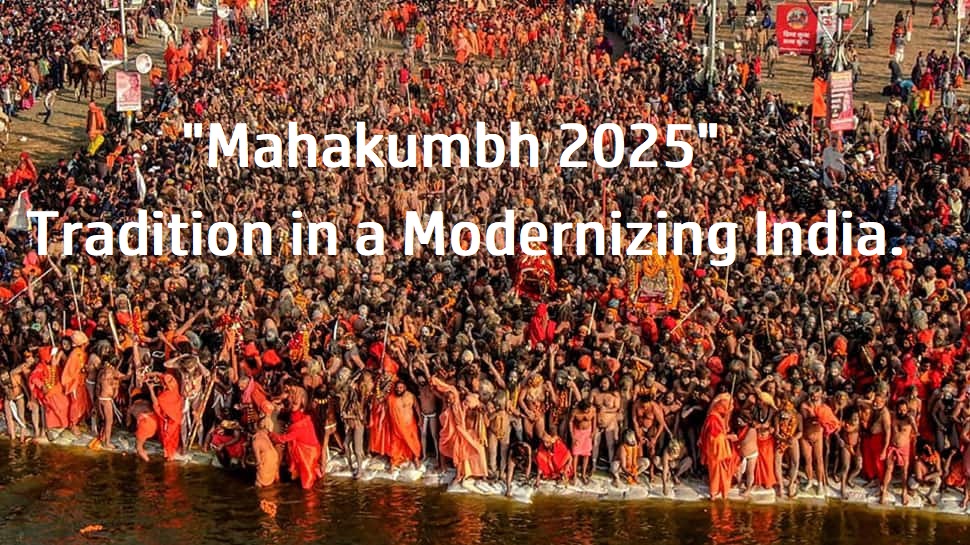Mahakumbh 2025: Tradition in a Modernizing India
India, a land of living traditions and dynamic transformations, stands at a unique intersection of continuity and change. Nowhere is this paradox more apparent than in the grand spiritual spectacle of the Mahakumbh Mela. As the world looks toward Mahakumbh 2025, to be held in Prayagraj, it becomes a powerful symbol of how ancient traditions are navigating and adapting within a rapidly modernizing society. This essay explores the multiple dimensions of Mahakumbh 2025—its spiritual, social, economic, and administrative relevance—in the backdrop of India’s modern developmental aspirations.
I. Mahakumbh: An Eternal Confluence of Faith
The Mahakumbh Mela is one of the oldest and largest religious gatherings in the world, occurring every 12 years at Prayagraj, at the sacred confluence of the Ganga, Yamuna, and the mythical Saraswati rivers. It rotates every three years among Haridwar, Ujjain, Nashik, and Prayagraj, with the Mahakumbh occurring after every fourth Kumbh at Prayagraj.
It is rooted in Puranic legends, particularly the tale of the Samudra Manthan, where drops of Amrit (nectar of immortality) fell at these four locations. More than mythology, Mahakumbh is an expression of India’s civilizational ethos—a celebration of unity, spirituality, knowledge-sharing, and collective cultural memory.
II. Mahakumbh 2025: The Scale and Significance
The Mahakumbh in 2025 saw an estimated 66 crore (660 million) visitors, making it the world’s largest human gathering. This is a significant increase from the 2013 Mahakumbh, which saw over 12 crore pilgrims.
Key Highlights of Mahakumbh 2025:
-
Digital Integration: Use of AI-powered crowd management systems, drone surveillance, and real-time dashboards.
-
Green Kumbh Initiative: Emphasis on eco-friendly infrastructure, plastic ban, and renewable energy sources.
-
Global Participation: Cultural diplomacy inviting foreign dignitaries, NRIs, and global spiritual leaders.
-
Inclusive Development: Special arrangements for divyangjans, senior citizens, and gender-sensitive facilities.
-
Economic Engine: Expected to generate over ₹1.2 lakh crore in tourism, trade, and infrastructure.
III. The Dance Between Tradition and Modernity
1. Technological Facilitation of Tradition
India’s digital leap is being harnessed to manage the scale and complexity of Mahakumbh. Integrated Command and Control Centers (ICCCs) are being set up to manage real-time data on crowd movement, medical emergencies, and sanitation. Pilgrims can register through mobile apps, access virtual maps, and receive alerts on weather and safety.
This does not dilute the spiritual core of the event; rather, it enhances accessibility and safety, especially for vulnerable groups. Technology here serves tradition, not replaces it.
2. Infrastructure for Spirituality
Modern India is building world-class infrastructure to facilitate age-old rituals. The six-lane roads, widened ghats, modular toilets, and high-speed rail connectivity do not hinder the sanctity of the festival but enable it to unfold more efficiently. For example, 40 pontoon bridges are being constructed to facilitate smoother movement across the Ganga.
3. Sanitation and Sustainability
One of the biggest criticisms of such mass gatherings has been environmental degradation. The Swachh Kumbh Mission, initiated during Kumbh 2019, is being scaled up in 2025 with solar-powered toilets, automated waste segregation, and water monitoring systems. The aim is to make Mahakumbh 2025 the first “Green Kumbh”, aligning with India’s Sustainable Development Goals (SDGs).
IV. Cultural Continuity and Social Cohesion
Despite urbanization and Western influence, faith continues to remain central to the Indian psyche. Events like Mahakumbh provide a rare public space for inter-generational transmission of values, rural-urban mingling, and the reaffirmation of communitarian identity. In an increasingly individualistic world, the Mahakumbh reminds us of collective spiritual experience.
Moreover, the event brings together Nagasadhus, priests, ascetics, common pilgrims, and even agnostics in a shared experience. In doing so, it performs a secular function through spiritual means—promoting social unity and harmony.
V. Economic and Diplomatic Potential
1. Local Economy Boost
According to the Uttar Pradesh Tourism Department, the 2019 Ardh Kumbh generated approximately ₹1.2 lakh crore, with over 13 crore visitors, including 1 lakh foreign tourists. Mahakumbh 2025, being a full Kumbh, is expected to surpass this, benefiting local artisans, weavers, transport workers, and small businesses.
2. Cultural Soft Power
Mahakumbh is now being leveraged as a tool of cultural diplomacy. With the G20 presidency recently concluded by India, the global spotlight is on India’s civilizational heritage. The Ministry of External Affairs has plans to invite foreign dignitaries to experience the Kumbh as a “living heritage of humanity”, echoing UNESCO’s recognition of Kumbh Mela in 2017.
VI. Administrative Challenges in a Modern Age
While modernization has aided the planning of Mahakumbh, it has also brought challenges:
-
Cybersecurity threats due to high digital dependence.
-
Managing misinformation on social media platforms.
-
Ensuring inter-agency coordination across departments like health, transport, disaster management, and law enforcement.
-
Mitigating stampedes and health emergencies during large shahi snan (royal bathing) days.
However, India’s experience in managing events like Kumbh 2019, G20 Summit 2023, and Kashi Vishwanath Corridor has equipped it with substantial administrative capabilities.
VII. Critiques and Counterpoints
Some scholars and commentators argue that the increasing politicization and commercialization of Mahakumbh could erode its spiritual essence. Concerns have also been raised about displacement of slum dwellers and ecological stress on the Ganga.
However, these challenges must be balanced against the larger cultural, spiritual, and economic value of the event. What is needed is not rejection, but responsible regulation and inclusive planning.
VIII. Mahakumbh and the Indian Future
As India aspires to become a developed country by 2047, events like Mahakumbh serve as anchors to cultural continuity. They are not relics of a superstitious past but living traditions that embody India’s pluralism, resilience, and adaptability.
Mahakumbh 2025 exemplifies how India is not discarding its traditions in the face of modernization, but is reimagining and reintegrating them into contemporary frameworks. It is not a choice between tradition and modernity, but a confluence of both—much like the Triveni Sangam itself.
Conclusion
Mahakumbh 2025 is more than a religious event—it is a civilizational statement. In its scale, spirit, and symbolism, it represents the ongoing dance between the timeless and the timely. In embracing both ritual and reform, tradition and technology, faith and functionality, Mahakumbh 2025 will mark a milestone in how India envisions its identity in the 21st century. It is a glowing testimony to the fact that modern India is not an antithesis of traditional India, but its rightful heir.


